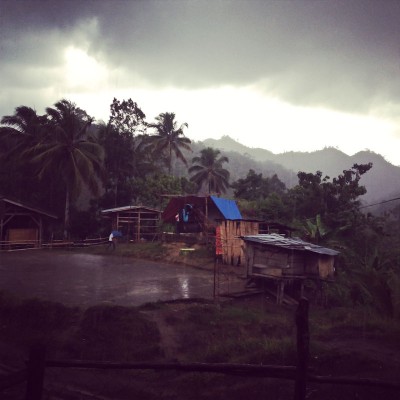Filipinos who live on less than $2 a day are being hurt, not helped, by their country’s economic boom.
I met Barbie Rergio on a scorching July day at her home in Payatas, one of the poorest areas in metropolitan Manila. She takes care of her baby niece while her sister is at work. From her window, beyond a few trees and a wire fence, I see concrete and cars.
Recently her neighbors’ homes were destroyed suddenly when the city decided to widen the road, she explains, and any day now, her home could be next.
My time with Rergio was part of a month-long exposure trip in the Philippines organized by BAYAN USA — an overseas chapter of BAYAN Philippines — to connect with the experiences and struggles of Filipinos in the homeland.
Rergio and her family are among the millions of peasants that have flocked from the countryside to the city in search of work and have settled along the esteros (creeks and rivers), building their homes where there was nothing.
She and her neighbors are among what people in the Philippines call the “urban poor”: the street vendors, the tricycle drivers, the garbage pickers — those who find odd jobs that pay less than $2 a day and can’t afford to go to college — a requirement for better employment opportunities.
These same areas are often considered “danger zones,” “problematic” and “eye sores” by mainstream Filipino. Meanwhile, policymakers and developers who hope to turn Manila into a business and tourism mecca are blaming poor, urban settlers for the recent flash floods, saying that their garbage and houses are blocking the waterways.
Yet it is these scapegoated families who have been the most affected by the floods, leaving their communities in devastating disarray.

In 2009, Typoon Ondoy killed more than 144 people in Rergio’s town, and overall, 956 lives were lost, with more than 700 people injured and 84 missing.
The death toll for the recent Typhoon Maring is now up to 21, while impacting more than 2.5 million Filipinos in the country.
Instead of helping these marginalized communities, the response from the Philippine government has been to remove and relocate them to areas far away from the city, and thus, schools, services and jobs, says Rergio.
“We have to do what it takes to take care of our families,” she says.
As she awaits her relocation, a group of scientists based in the Philippines is working to dispel the myth that her people are the problem.
Gravity and Resistance
“It is important to first understand flooding.” Ricardo Saturay told organizations at a teach-in on July 8 at the BAYAN National Capitol Headquarters in Quezon City.
The University of the Philippines geologist is a member of a scientists’ group, Advocates of Science & Technology for the People, or “AGHAM,” AGHAM has stepped up to challenge the negative stereotypes used by the government and media to portray the urban poor, and instead illuminate the actual causes and solutions to the floods.
Saturay explained that heavy rainfalls in the Philippines during the months of July and August are not new, though areas like Mindanao have seen deadly typhoons for the first time due to climate change and years of illegal mining and deforestation by foreign corporations.

When the rain comes down, it gathers velocity because of the gravity and meets resistance while running through trees and absorbing into the soil and plant life along the rivers and creeks — also known as a watershed.
The balancing act of gravity and resistance has prevented most flooding in the past.
However, the plants, trees and soil are no longer there to resist and absorb runoff, but are being replaced with cement roads and structures that don’t do the job. AGHAM made clear that the urban poor along the esteros are not to blame for flooding; it’s actually the destruction of watersheds by development. As rain falls beyond watershed capacity, urban areas become like a clogged drain, overflowing with water and causing flash floods.
“The solution is not to demolish, but to build infrastructure that is systematic to urban planning with proper drainage and to revive the watersheds,” said Saturay in his presentation. “We are not against development, but it needs to work for the people who live there and be area-specific, not a blanket solution.”
The People’s Resistance to Bureaucracy
Government and private developers have turned to using force, sending demolition crews and police to take down houses. Urban poor communities are responding by setting up barricades and facing these crews head on in order to protect their homes.
Einde Bagasbas, is a community leader with Kalipunan ng Damayang Mahihirap (Organization of the Urban poor and Unemployed, also called “Kadamay” ). In July, she witnessed a street battle between her community and the demolition crews in the North Triangle area.
“When they were coming, we put up a barricade in the street and stood in the way,” she remembers. “The police attacked an elderly woman, hit her on the head and blood came out (she needed six stitches). So we then clashed. Later, they said that we started it. We’re spreading the word to other barangays [towns] that we can protect our homes.”
Amidst the recent devastation of Typhoon Maring, advocates have exposed the Aquino Administration and Philippine Congress’ Priority Development Assistance Fund, which contains $141 Million (1.3 trillion to 1.5 trillion in Philippine pesos) for misusing government funds.
On Aug. 26, tens of thousands of Filipinos in Manila participated in a “Million People March.” The protesters at the march, organized by BAYAN, pressured government officials to stop corruption, and instead, allocate misused funds towards social services and natural disaster preparedness.
As Manila continues to gentrify, basic needs such as water, health care, education and transportation become out of reach to everyday Filipinos through Aquino’s U.S.-influenced Private Public Partnership Plan. Bagasbas, Rergio and their communities struggle to survive.
Filipino activists here and abroad are urging the Philippine government to not just develop long-term solutions for flooding, but address the root causes of poverty and the need for jobs and land for the Filipino people.
By joining international organizations that work directly with the peoples’ movements abroad, such as BAYAN and the International League of Peoples’ Struggle (ILPS), we, too, can pressure the U.S. government and corporations to stop influencing and controlling the Philippines and other countries.
Jill will share more of their recent experiences in the Philippines at the BAYAN PNW community report-back, “Tahanan” (“Home” in Tagalog) on Sept. 14, 7 p.m.-9 p.m., at WAPI DUNGEON (3722 South Hudson Street, Seattle). Proceeds will go towards further exposure trips and community organizations in the Philippines.
This story was originally published in the International Examiner.




